Using a Digital Twin to Study the Influence of Climatic Changes on High Ozone Levels in Bulgaria and Europe
Abstract
:1. Introduction
2. Major Characteristics of the Unified Danish Eulerian Model
- (a)
- the spatial derivatives in (1) are discretized directly,
- (b)
- the First-order Backward Differentiation Formula, is applied in the solution of the large and stiff system of ordinary differential equations (ODEs) that appear after the discretization of the spatial derivatives,
- (c)
- the chemical scheme, namely CBM-IV scheme with 56 chemical species is selected and,
- (d)
- the model is run over a time interval of 16 years.
3. Development of Climatic Scenarios for the Unified Danish Eulerian Model
3.1. Basic Scenario
3.2. First Climatic Scenario
3.3. Second Climatic Scenario
- The maximal daily temperatures will become higher and the number of hot days in the land areas will increase.
- There will be higher minimum temperatures, fewer cold days and fewer frost days over nearly all land areas.
- The diurnal temperature range will be reduced over land areas.
- (a)
- the temperatures during the night-time are increased with a factor larger than the factor by which the day-time temperatures were increased,and
- (b)
- the day-time the temperatures are increased by a larger value in hot days during the summer periods.
3.4. Third Climatic Scenario
- The precipitation events during winter were increased both over land and over water.
- The precipitation events in the continental part of Europe were reduced.
- Similar changes of the humidity data were made.
- The cloud covers were increased by 10% during winter, while the same cloud covers, as those in the Second Climatic Scenario were applied during summer.
3.5. Scenario Related to the Natural (Biological) Emissions
- The human-made (anthropogenic) emissions were permanently reduced in many European countries during the last two-three decades.
- The future climatic changes and the higher temperatures will cause an increase of the natural (biological) emissions.
4. Influence of the Climatic Changes on Air Pollution Levels in Europe
4.1. Distribution of the “Bad Days” in Europe
- (a)
- It can be seen that both the distribution of the “bad days” in the different parts of Europe and the numbers of the “bad days” can vary very much from one year to another year (compare the two left-hand-side plots in Figure 3 where the results from the Basic Scenario are given for years 1994 and 2004).
- (b)
- The application of the Third Climatic Scenario is normally resulting in an increase of the numbers of “bad days”. The changes can be very significant (see the right-hand side plots where the increases, in percent, of the numbers of “bad days” are given for the two selected years).
- (c)
- In many parts of Europe, the numbers of “bad days” are considerable larger than the prescribed limit of 25 days.
4.2. Variation of the Numbers of “Bad Days” in Several Major Cities in Europe
- (a)
- The numbers of the “bad days” are as a rule decreasing at the end of the period of sixteen years. However, this is not always the case; see the results for Naples and Stockholm.
- (b)
- The numbers of “bad days” are very often greater (and even much greater) than the limit of 25. At some of the cities, as Innsbruck and Naples, this is true for all 16 years.
- (c)
- The results for Belfast and Stockholm indicate that the numbers of “bad days” is staying under or close to 25 in the regions far to the West and to the North. The same conclusion can also be seen for the two selected years (1994 and 2004) in the plots in Figure 3.
4.3. Influence of the Natural (Biogenic) Emissions on Pollution Levels in Europe
5. Influence of the Climatic Changes on Pollution Levels in Bulgaria
- (a)
- the distribution of the “bad days” in the chosen domain,
- (b)
- the occurrences of “bad days” in several Bulgarian towns,
- (c)
- and the increases of the numbers of “bad days” when the scenario with increased natural (biological) emissions is applied.
5.1. Distribution of the “Bad Days” in the Area Containing Bulgaria and its Surroundings
- (a)
- Both the distribution of the “bad days” in the different parts of Bulgaria and the numbers of the “bad days” can vary very much from one year to another year (compare the two left-hand-side plots in Figure 7 where the results from the Basic Scenario are given for years 1993 and 2003).
- (b)
- The application of the Third Climatic Scenario is normally resulting in an increase of the numbers of “bad days”. The changes can be very significant (see the right-hand side plots in Figure 7, where the increases, in percent, of the numbers of “bad days” are given for the two selected years). It is also seen that the changes for 2003 are in general greater than the corresponding changes for 1993.
- (c)
- The numbers of “bad days” are often larger than the prescribed limit of 25 days.
5.2. Variation of the Numbers of “Bad Days” in Several Bulgarian Towns
- (a)
- The numbers of the “bad days” are as a rule decreasing at the middle of the period of 16 years. It is not very clear what the reason for this behaviour is.
- (b)
- The numbers of “bad days” are often greater than the limit of 25.
- (c)
5.3. Influence of the Natural (Biogenic) Emissions on Pollution Levels in Bulgaria
6. Discussion and Concluding Remarks
6.1. The “Bad Days”
- (a)
- The numbers of “bad days” can be larger than the limit of 25 days, both in many regions of Europe and in many places of Bulgaria. People suffering from asthmatic deceases will have difficulties during the long periods with such days. Therefore, it is advisable to take the needed measures for the reduction of the long periods of “bad days”.
- (b)
- It is highly desirable to develop devices for predicting the coming of periods of “bad days” in a reliable way. If this is done, then the responsible authorities should take care to inform in a good time the people with asthmatic diseases for the coming danger.
- (c)
- Some further research about the effects of long sequences of “bad days” on people with asthmatic deceases will also very be very useful.
6.2. The Computational Difficulties
- (a)
- The amount of the input data (both meteorological data and emission data) is enormous. Moreover, it is necessary to apply reliable data sets of input data. Such data sets were obtained from the EMEP database [1,40,41], included in DIGITAL AIR and used in all runs. The sets of output data, which have to be preserved and analysed, are also extremely big.
- (b)
- It is necessary to apply fine discretization, especially in the efforts to obtain reliable information about small European countries (as, for example, Bulgaria and Hungary). Therefore, (10 km × 10 km) cells are to be used. The computational work needed to calculate the desired information is enormous. This was explained in Section 2. The difficult computational problems were resolved by applying the efficient numerical methods discussed in [14,26].
- (c)
- However, the use of efficient numerical methods is by no means enough. It was also necessary to run UNI-DEM on powerful and fast parallel computers. The BLUE GENE computer in Sofia was used in many of the runs.
6.3. The Climatic Scenarios
- (a)
- The climatic changes will lead to a considerable increase of the ozone concentrations. These high levels may have damaging effects on some groups of human beings.
- (b)
- No increases or small increases only of the ozone concentrations were detected in the parts of Europe, which are located far to the North and far to the West (mostly in Northern Ireland and in the Northern parts of Scandinavia, Finland and the Russian Federation).
- (c)
- The increases of the dangerous ozone concentrations in Bulgaria are not as high as the increases in some countries in Central and Southern Europe, such as Germany and Italy, but these increases can nevertheless have very damaging effects on some groups of human beings.
6.4. Conclusions
- (a)
- A mathematical model, UNI-DEM, which must be handled by using efficient and accurate numerical algorithms on fast modern supercomputers.
- (b)
- Many large sets of input data (and first and foremost meteorological data, emission data and geographical data).
- (c)
- A set of carefully prepared climatic scenarios describing both the increase of the temperature in the future and the increase of the natural (biogenic) emissions.
- (d)
- Many graphical programs, by which the obtained numerical results can be visualized.
Author Contributions
Funding
Institutional Review Board Statement
Informed Consent Statement
Data Availability Statement
Conflicts of Interest
References
- Hass, H.; Ebel, A.; Feldmann, H.; Jakobs, H.; Memmesheimer, M. Evaluation studies with a regional chemical transport model (EURAD) using air quality data from the EMEP monitoring network. Atmos. Environ. Part A Gen. Top. 1993, 27, 867–887. [Google Scholar] [CrossRef]
- Balogun, A.-L.; Marks, D.; Sharma, R.; Shekhar, H.; Balmes, C.; Maheng, D.; Arshad, A.; Salehi, P. Assessing the Potentials of Digitalization as a Tool for Climate Change Adaptation and Sustainable Development in Urban Centres. Sustain. Cities Soc. 2020, 53, 101888. [Google Scholar] [CrossRef]
- Bauer, P.; Stevens, B.; Hazeleger, W. A digital twin of Earth for the green transition. Nat. Clim. Chang. 2021, 11, 80–83. [Google Scholar] [CrossRef]
- Costantini, A.; Di Modica, G.; Ahouangonou, J.C.; Duma, D.C.; Martelli, B.; Galletti, M.; Antonacci, M.; Nehls, D.; Bellavista, P.; Delamarre, C.; et al. IoTwins: Toward Implementation of Distributed Digital Twins in Industry 4.0 Settings. Computers 2022, 11, 67. [Google Scholar] [CrossRef]
- Dembski, F.; Wössner, U.; Letzgus, M.; Ruddat, M.; Yamu, C. Urban Digital Twins for Smart Cities and Citizens: The Case Study of Herrenberg, Germany. Sustainability 2020, 12, 2307. [Google Scholar] [CrossRef] [Green Version]
- Dwivedi, Y.K.; Hughes, L.; Kar, A.K.; Baabdullah, A.M.; Grover, P.; Abbas, R.; Andreini, D.; Abumoghli, I.; Barlette, Y.; Bunker, D.; et al. Climate change and COP26: Are digital technologies and information management part of the problem or the solution? An editorial reflection and call to action. Int. J. Inf. Manag. 2021, 63, 102456. [Google Scholar] [CrossRef]
- Houghton, J.T.; Ding YD, J.G.; Griggs, D.J.; Noguer, M.; van der Linden, P.J.; Dai, X.; Maskell, K.; Johnson, C.A. Climate Change 2001: The Scientific Basis; Cambridge University Press: Cambridge, UK; New York, NY, USA, 2001. [Google Scholar]
- Nativi, S.; Mazzetti, P.; Craglia, M. Digital Ecosystems for Developing Digital Twins of the Earth: The Destination Earth Case. Remote Sens. 2021, 13, 2119. [Google Scholar] [CrossRef]
- Pedersen, A.; Borup, M.; Brink-Kjær, A.; Christiansen, L.; Mikkelsen, P. Living and Prototyping Digital Twins for Urban Water Systems: Towards Multi-Purpose Value Creation Using Models and Sensors. Water 2021, 13, 592. [Google Scholar] [CrossRef]
- Peters, L.K.; Berkowitz, C.M.; Carmichael, G.R.; Easter, R.C.; Fairweather, G.; Ghan, S.J.; Hales, J.M.; Leung, L.R.; Pennell, W.R.; Potra, F.A.; et al. The current state and future direction of Eulerian models in simulating the tropospheric chemistry and transport of trace species: A review. Atmos. Environ. 1995, 29, 189–222. [Google Scholar] [CrossRef]
- Zannetti, P. Air Pollution Modelling: Theories, Computational Methods and Available Software; Springer Science and Business Media: New York, NY, USA, 1990. [Google Scholar] [CrossRef]
- Zlatev, Z. Computer Treatment of Large Air Pollution Models; Kluwer Academic Publishers: Dordrecht, The Netherlands, 1995. [Google Scholar] [CrossRef]
- Zlatev, Z.; Dimov, I. Computational and Numerical Challenges in Environmental Modelling; Elsevier: Amsterdam, The Netherlands, 2006. [Google Scholar] [CrossRef]
- Zlatev, Z.; Dimov, I.; Farago, I.; Georgiev, K.; Havasi, A. Large-scale air pollution modeling in Europe under different climatic scenarios. Int. J. Big Data Min. Glob. Warm. 2019, 1, 1950009. [Google Scholar] [CrossRef]
- Zlatev, Z.; Dimov, I.; Georgiev, K. Relations between Climatic Changes and High Pollution Levels in Bulgaria. Open J. Appl. Sci. 2016, 06, 386–401. [Google Scholar] [CrossRef] [Green Version]
- Zlatev, Z.; Faragó, I.; Havasi, Á. Impact of Climatic Changes on Pollution Levels. In Mathematical Problems in Meteoro-Logical; Series on “Mathematics in Industry”; Bátkai, A., Csomós, P., Faragó, I., Horányi, A., Szépszó, G., Eds.; Springer: Berlin/Heidelberg, Germany, 2016; Volume 24, pp. 129–161. Available online: https://www.semanticscholar.org/paper/Impact-of-Climatic-Changes-on-Pollution-Levels-Zlatev-Farag%C3%B3/4539573cdff40c8831c87f9be05e460aea449fcf (accessed on 1 June 2022).
- Zlatev, Z.; Georgiev, K.; Dimov, I. Influence of climatic changes on pollution levels in the Balkan Peninsula. Comput. Math. Appl. 2013, 65, 544–562. [Google Scholar] [CrossRef]
- IPCC Climate Change. The Physical Science Basis. Contribution of the Working Group I to the Fourth Assessment Report of IPCC. Intergovernmental Panel on Climate Change; Cambridge University Press: Cambridge, UK; New York, NY, USA, 2007; Volume 996, pp. 113–119. [Google Scholar]
- Jacobson, M.Z. On the causal link between carbon dioxide and air pollution mortality. Geophys. Res. Lett. 2008, 35. [Google Scholar] [CrossRef] [Green Version]
- Vrchota, J.; Pech, M.; Rolínek, L.; Bednář, J. Sustainability Outcomes of Green Processes in Relation to Industry 4.0 in Manufacturing: Systematic Review. Sustainability 2020, 12, 5968. [Google Scholar] [CrossRef]
- Zlatev, Z.; Moseholm, L. Impact of climate changes on pollution levels in Denmark. Ecol. Model. 2008, 217, 305–319. [Google Scholar] [CrossRef]
- Zlatev, Z.; Syrakov, D. A fine-resolution modelling study of pollution levels in Bulgaria. Part 1: SO2 and NO2 pollution. Int. J. Environ. Pollut. 2004, 22, 186–202. [Google Scholar] [CrossRef]
- Zlatev, Z.; Syrakov, D. A fine-resolution modelling study of pollution levels in Bulgaria. Part 2: High ozone levels. Int. J. Environ. Pollut. 2004, 22, 203–222. [Google Scholar] [CrossRef]
- Ostromsky, T.Z.; Todorov, V.; Dimov, I.; Georgieva, R.; Zlatev, Z.; Poryazov, S. Sensitivity Study of Large-Scale Air Pollution Model Based on Modifications of the Latin Hypercube Sampling Method. In Lecture Notes in Computer Science; Springer: Cham, Switzerland, 2022; pp. 156–163. [Google Scholar]
- Todorov, V.; Dimov, I.; Ostromsky, T.; Apostolov, S.; Georgieva, R.; Dimitrov, Y.; Zlatev, Z. Advanced stochastic approaches for Sobol’ sensitivity indices evaluation. Neural Comput. Appl. 2020, 33, 1999–2014. [Google Scholar] [CrossRef]
- Zlatev, Z. Impact of future climatic changes on high ozone levels in European suburban areas. Clim. Chang. 2009, 101, 447–483. [Google Scholar] [CrossRef]
- Ackermann, I.J.; Hass, H.; Schell, B.; Binkowski, F.S. Regional modelling of particulate matter with MADE. Environ. Manag. Health 1999, 10, 201–208. [Google Scholar] [CrossRef] [Green Version]
- Bell, M.L.; Goldberg, R.; Hogrefe, C.; Kinney, P.L.; Knowlton, K.; Lynn, B.; Rosenthal, J.; Rosenzweig, C.; Patz, J.A. Climate change, ambient ozone, and health in 50 US cities. Clim. Chang. 2007, 82, 61–76. [Google Scholar] [CrossRef]
- Borrell, P.; Borrell, P.M.; Seiler, W.; Csitas, T. Transport and Transformation of Pollutants in the Troposphere; Springer: Berlin, Germany, 2000. [Google Scholar] [CrossRef]
- Carmichael, G.R.; Peters, L.K. An Eulerian transport/transformation/removal model for SO2 and Sulphate—I. Model development. Atmos. Environ. 1984, 18, 937–951. [Google Scholar] [CrossRef]
- Carmichael, G.R.; Peters, L.K. A second generation model for regional-scale transport/chemistry/deposition. Atmos. Environ. 1986, 20, 173–188. [Google Scholar] [CrossRef]
- Chang, J.S.; Brost, R.A.; Isaksen, I.S.A.; Madronich, S.; Middleton, P.; Stockwell, W.; Walcek, C.J. A three-dimensional Eulerian acid deposition model: Physical concepts and formulation. J. Geophys. Res. Earth Surf. 1987, 92, 14681–14700. [Google Scholar] [CrossRef]
- Ebel, A.; Memmesheimer, M.; Jakobs, H.J. Regional Modelling of Tropospheric Ozone Distributions and Budgets. In Atmospheric Ozone Dynamics: I. Global Environmental Change; NATO ASI Series; Varotsos, C.C., Ed.; Springer: Berlin/Heidelberg, Germany, 1997; Volume 53, pp. 37–57. ISBN 978-3-642-60797-4. [Google Scholar]
- Hass, H.; Jakobs, H.J.; Memmesheimer, M. Analysis of a regional model (EURAD) near surface gas concentration predictions using observations from networks. Meteorol. Atmos. Phys. 1995, 57, 173–200. [Google Scholar] [CrossRef]
- Hou, L.; Wu, S.; Zhang, G.; Tan, Y.; Wang, X. Literature Review of Digital Twins Applications in Construction Workforce Safety. Appl. Sci. 2021, 11, 339. [Google Scholar] [CrossRef]
- Klippel, A.; Sajjadi, P.; Zhao, J.; Wallgrün, J.O.; Huang, J.; Bagher, M.M. Embodied digital twins for environmental applications. ISPRS Ann. Photogramm. Remote Sens. Spat. Inf. Sci. 2021, 4, 193–200. [Google Scholar] [CrossRef]
- Simpson, D.; Guenther, A.; Hewitt, C.N.; Steinbrecher, R. Biogenic emissions in Europe: 1. Estimates and uncertainties. J. Geophys. Res. Earth Surf. 1995, 100, 22875–22890. [Google Scholar] [CrossRef] [Green Version]
- Stocker, T.F.; Qin, D.; Plattner, G.-K.; Tignor, M.; Allen, S.K.; Boschung, J.; Nauels, A.; Xia, Y.; Bex, V.; Midgley, P.M. (Eds.) Climate Change 2013: The Physical Basis; Contribution of the Working Group I of the Intergovernmental Panel on Climate Change; Cambridge University Press: Cambridge, UK; New York, NY, USA, 2013. [Google Scholar]
- Venkatram, A.; Karamchandani, P.; Misra, P. Testing a comprehensive acid deposition model. Atmos. Environ. 1988, 22, 737–747. [Google Scholar] [CrossRef]
- Working Group I to the Sixth Assessment Report of the Intergovernmental Panel on Climate Change; Masson-Delmotte, V.; Zhai, A.P.; Pirani, S.L.; Connors, C.; Péan, S.; Berger, N.; Caud, Y.; Chen, L.; Goldfarb, M.I.; et al. (Eds.) IPCC, 2021: Summary for Policymakers. In Climate Change 2021: The Physical Science Basis; Cambridge University Press: Cambridge, UK, 2021. [Google Scholar]
- Gery, M.W.; Whitten, G.Z.; Killus, J.P.; Dodge, M.C. A photochemical kinetics mechanism for urban and regional scale computer modeling. J. Geophys. Res. Earth Surf. 1989, 94, 12925–12956. [Google Scholar] [CrossRef]
- Anastasi, C.; Hopkinson, L.; Simpson, V. Natural hydrocarbon emissions in the United Kingdom. Atmos. Environ. Part A Gen. Top. 1991, 25, 1403–1408. [Google Scholar] [CrossRef]
- Stockwell, W.; Kirchner, F.; Kuhn, M.; Seefeld, S. A new mechanism for regional atmospheric chemistry modeling. J. Geophys. Res. Earth Surf. 1997, 102, 25847–25879. [Google Scholar] [CrossRef] [Green Version]
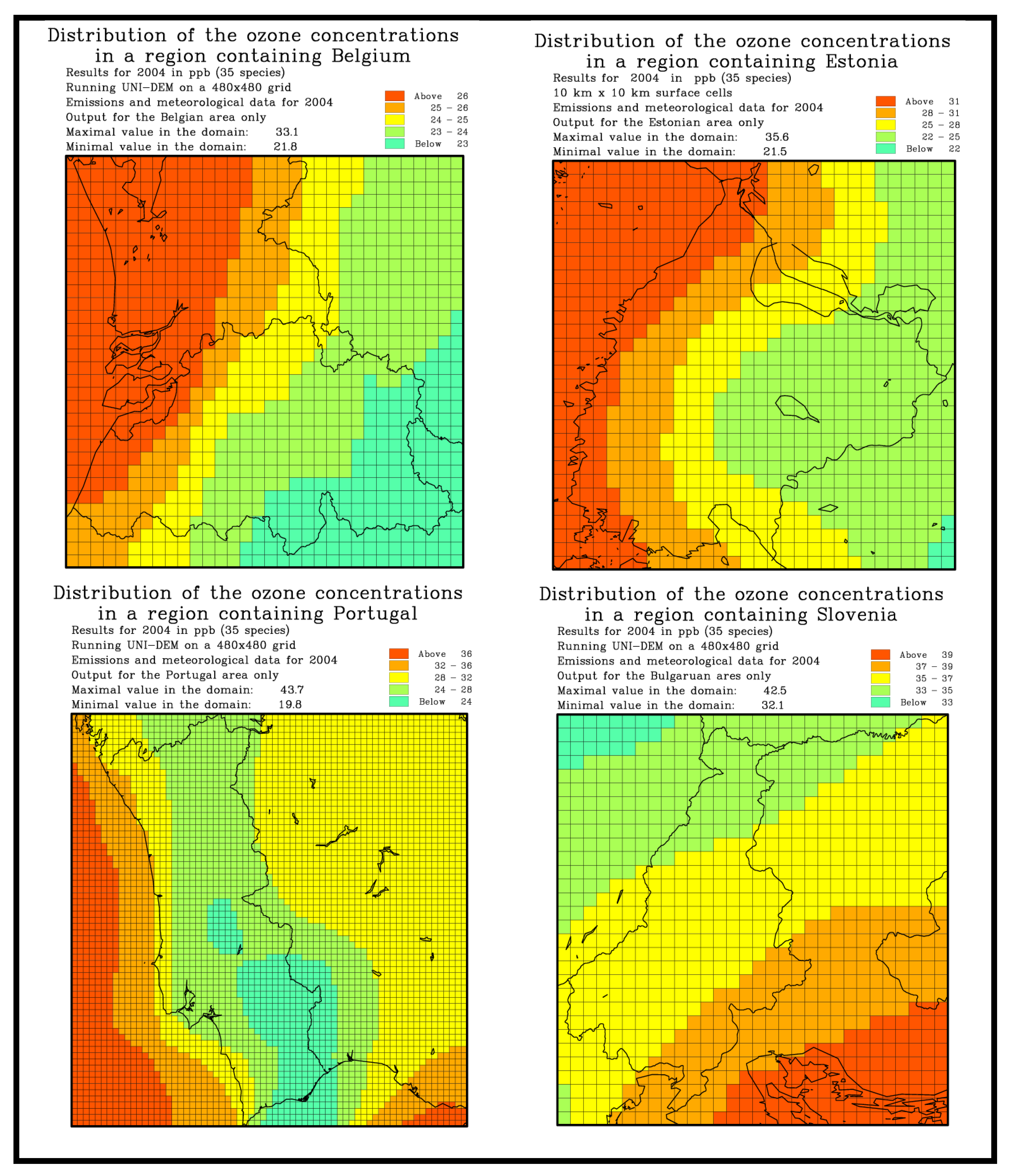
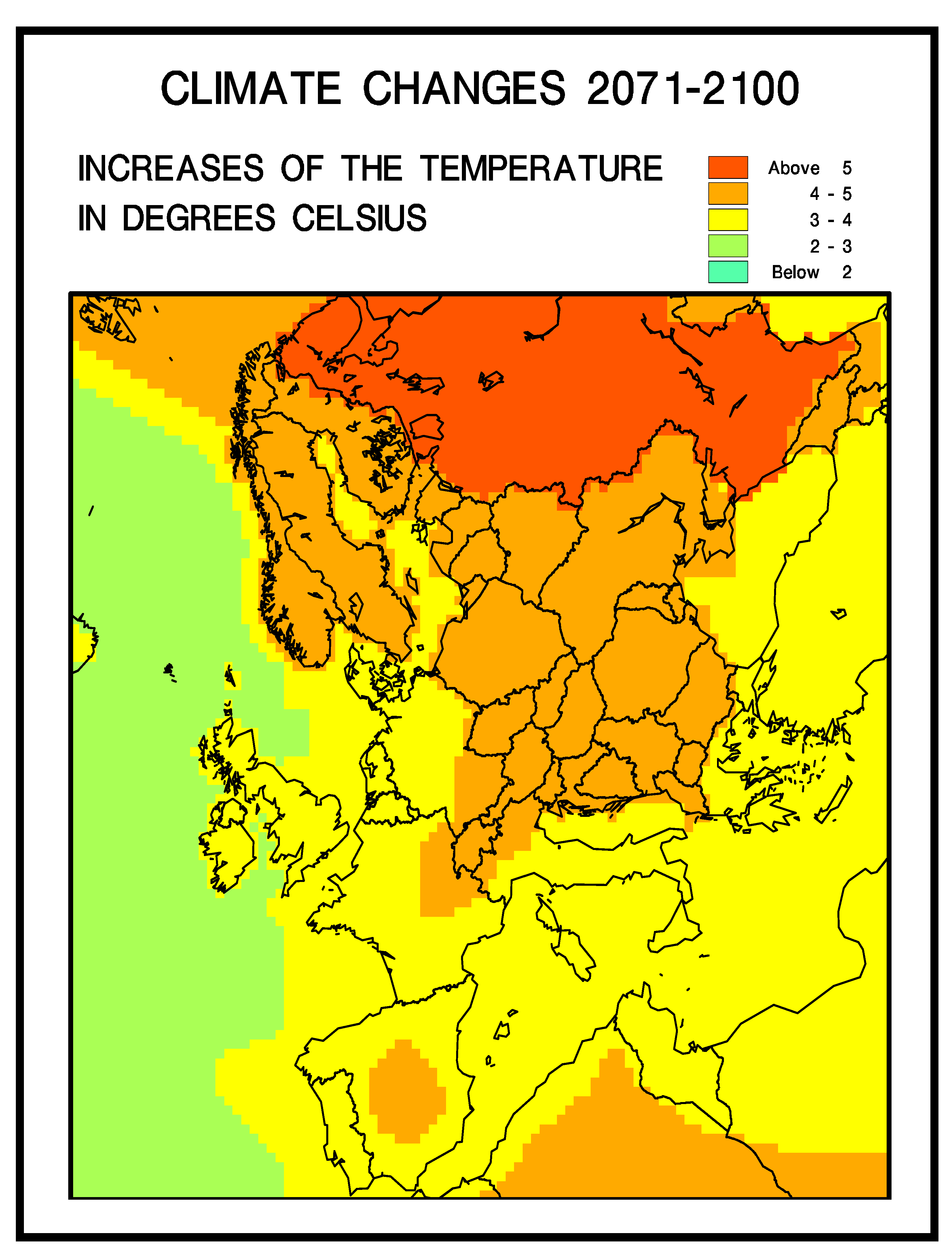
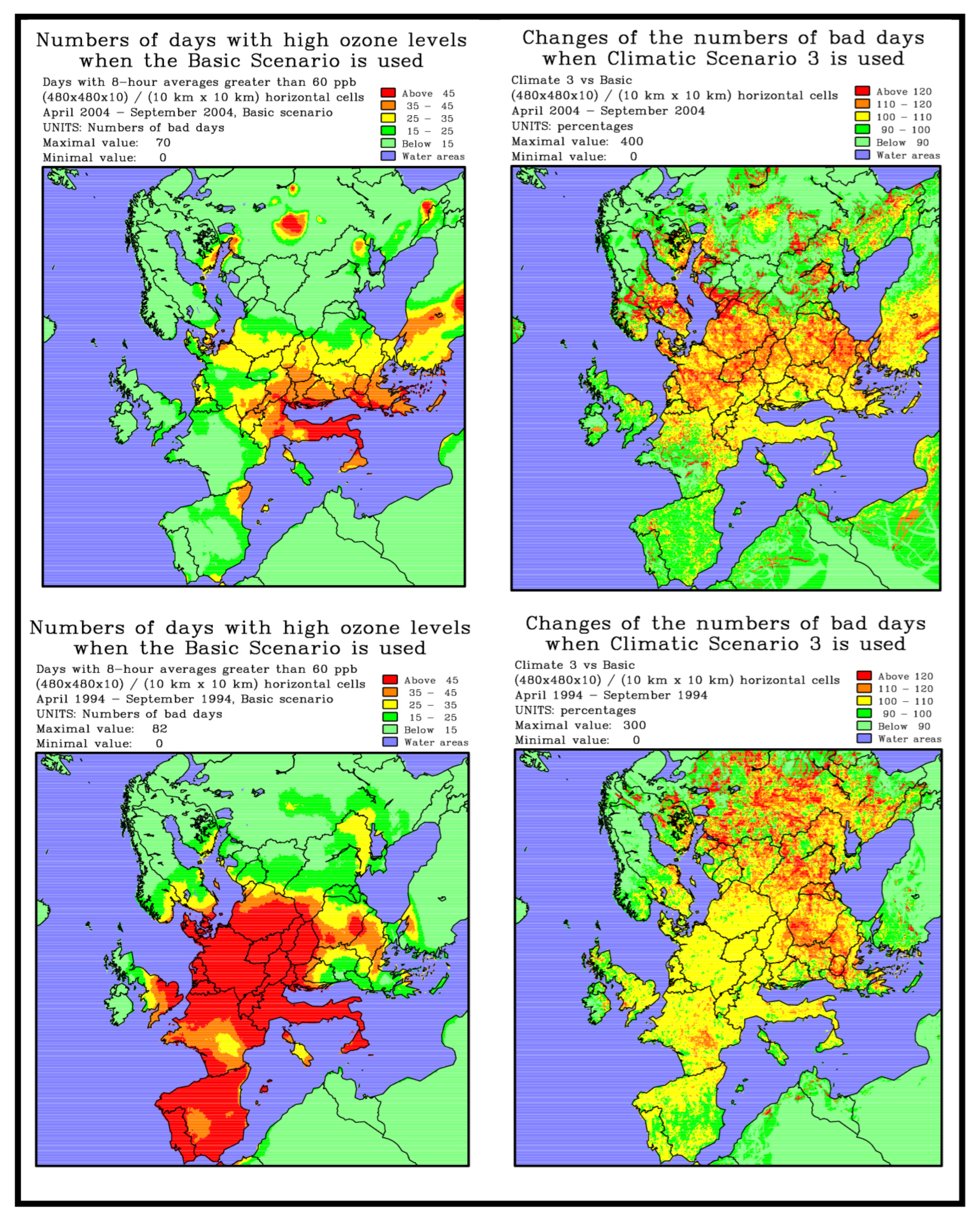

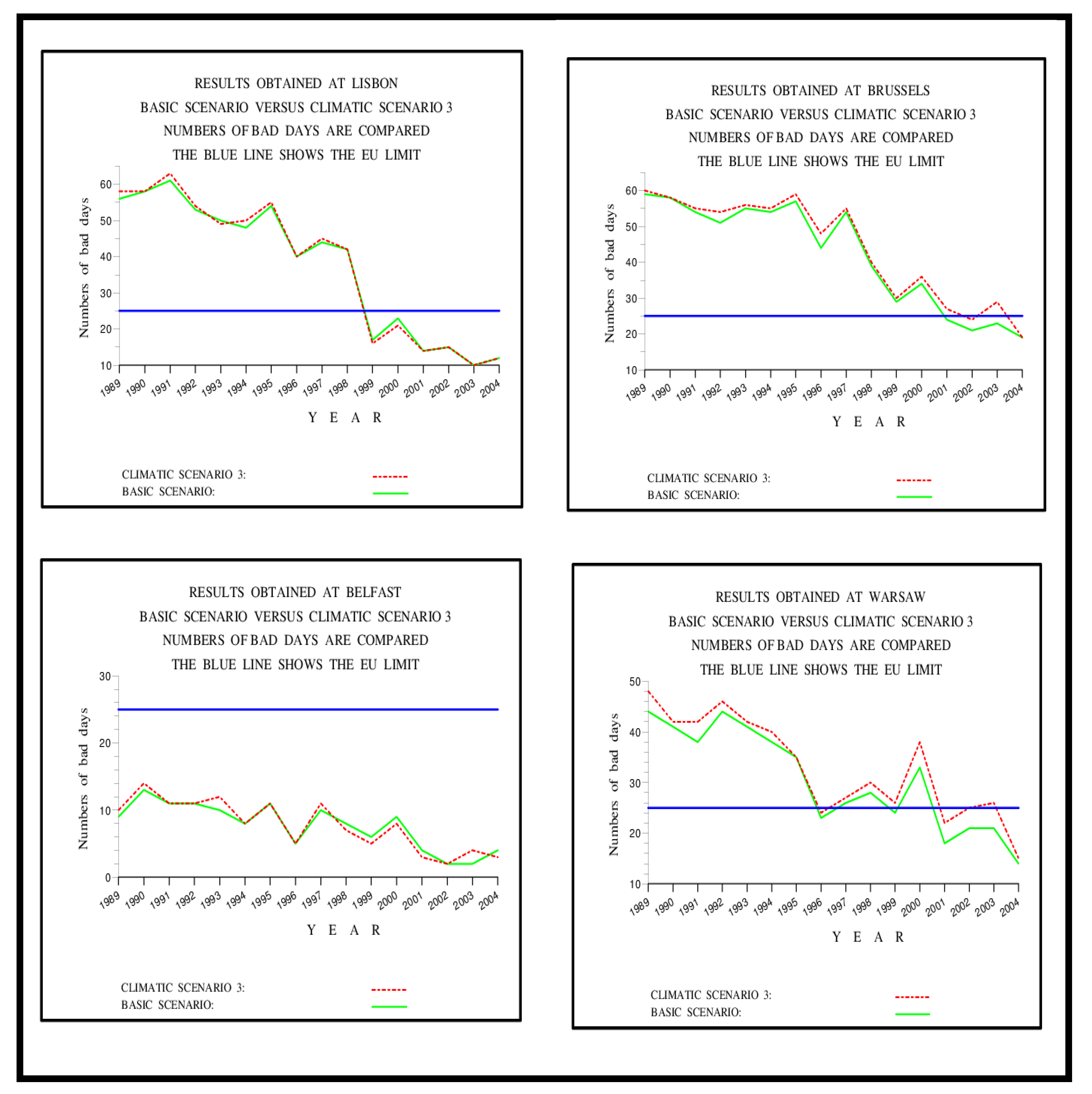

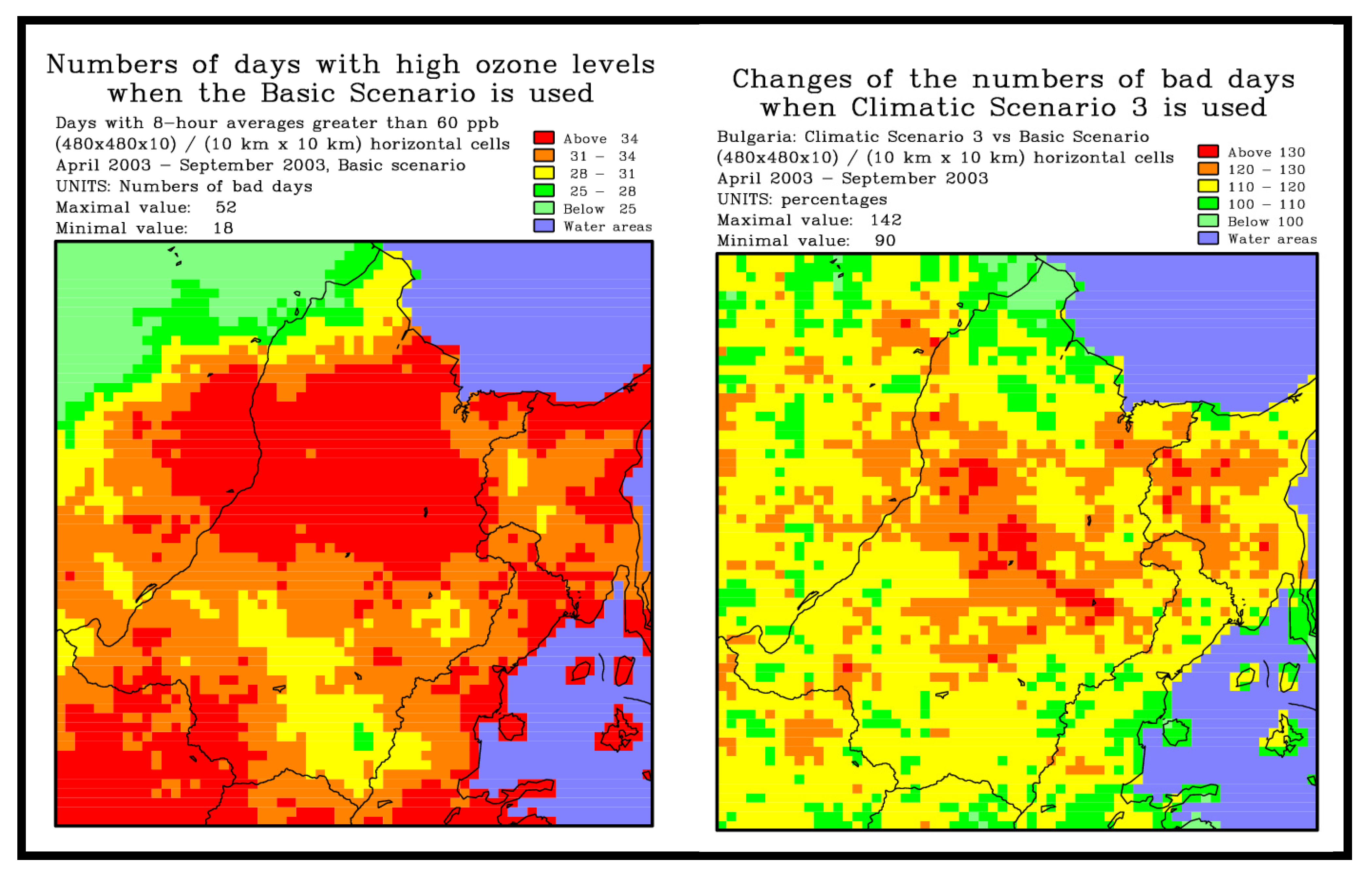

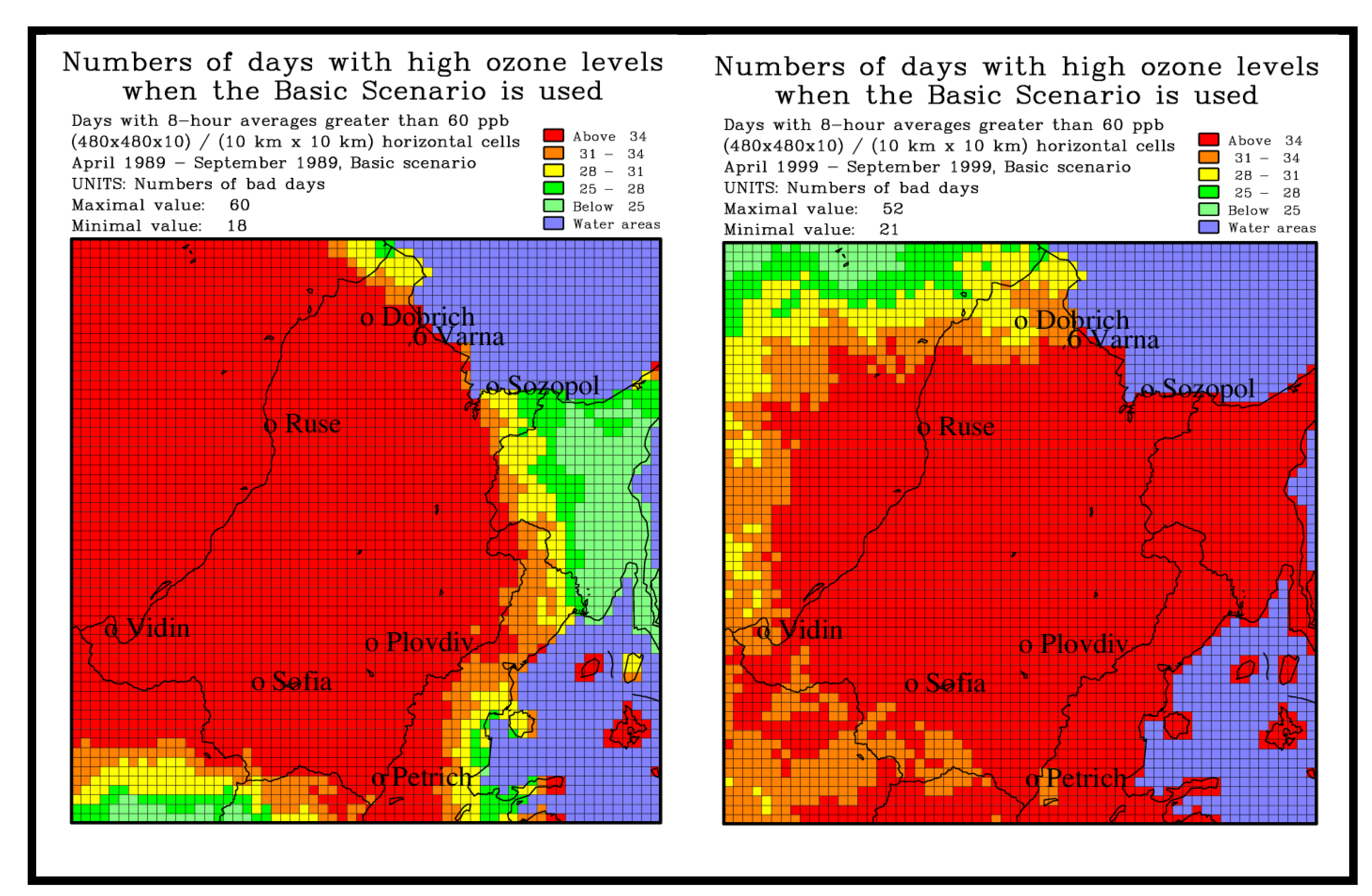

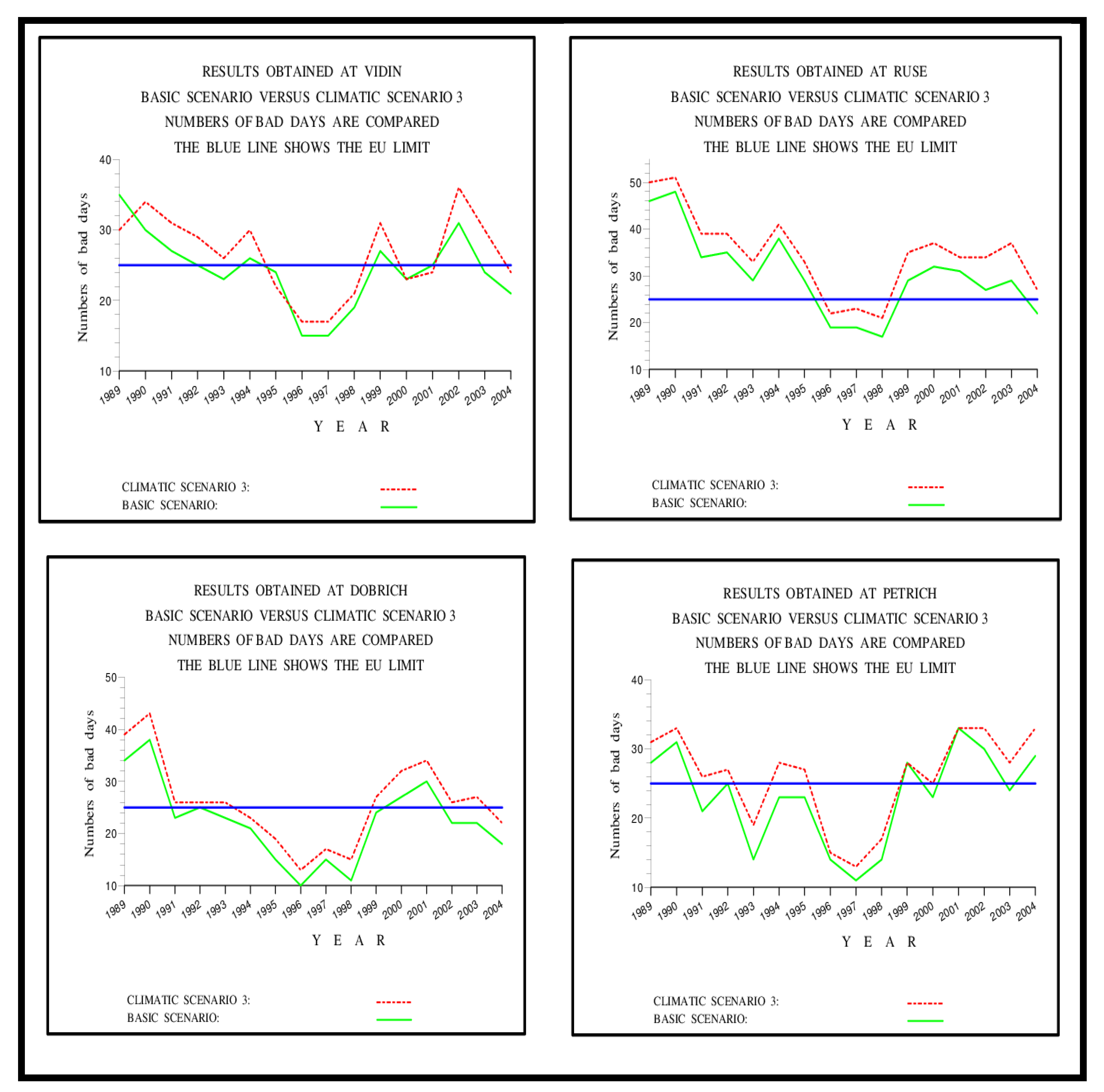

Publisher’s Note: MDPI stays neutral with regard to jurisdictional claims in published maps and institutional affiliations. |
© 2022 by the authors. Licensee MDPI, Basel, Switzerland. This article is an open access article distributed under the terms and conditions of the Creative Commons Attribution (CC BY) license (https://creativecommons.org/licenses/by/4.0/).
Share and Cite
Zlatev, Z.; Dimov, I. Using a Digital Twin to Study the Influence of Climatic Changes on High Ozone Levels in Bulgaria and Europe. Atmosphere 2022, 13, 932. https://doi.org/10.3390/atmos13060932
Zlatev Z, Dimov I. Using a Digital Twin to Study the Influence of Climatic Changes on High Ozone Levels in Bulgaria and Europe. Atmosphere. 2022; 13(6):932. https://doi.org/10.3390/atmos13060932
Chicago/Turabian StyleZlatev, Zahari, and Ivan Dimov. 2022. "Using a Digital Twin to Study the Influence of Climatic Changes on High Ozone Levels in Bulgaria and Europe" Atmosphere 13, no. 6: 932. https://doi.org/10.3390/atmos13060932
APA StyleZlatev, Z., & Dimov, I. (2022). Using a Digital Twin to Study the Influence of Climatic Changes on High Ozone Levels in Bulgaria and Europe. Atmosphere, 13(6), 932. https://doi.org/10.3390/atmos13060932





